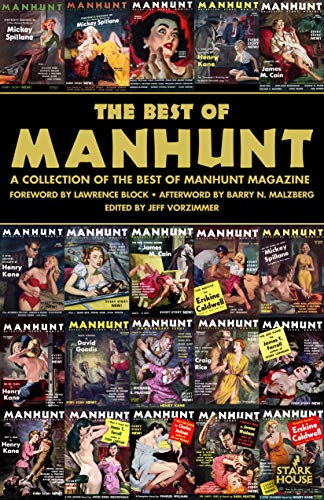 Last week, I looked at the The Manhunt Companion which I had picked up last year at Pulpfest. I picked up The Best of Manhunt at Mike Chomko’s table at Pulpfest this year the first day.
Last week, I looked at the The Manhunt Companion which I had picked up last year at Pulpfest. I picked up The Best of Manhunt at Mike Chomko’s table at Pulpfest this year the first day.
The Best of Manhunt (Stark House, 2019) is in trade paperback format, 384 pages, edited by Jeff Vorzimmer. Introduction by Jeff Vorzimmer, foreword by Lawrence Block, afterword by Barry N. Malzberg. A total of 39 stories. This volume includes thirteen stories in the Permabook paperback The Best From Manhunt (1958) and six more from the U.K. paperback. The Bloodhound Anthology (1959).
I recognized a few of the authors: Evan Hunter, Erskine Caldwell, Steve Frazee, Mickey Spillane, David Goodis, John D. MacDonald, Gil Brewer, Harlan Ellison, Harry Whittington, Donald Westlake, Lawrence Block, Fredric Brown.
There were other authors that were totally new to me or encountered once in American Pulp and The Mammoth Book of Pulp Fiction: Richard Deming, Helen Nielsen, Fletcher Flora, Jonathon Lord, Jonathan Craig, Craig Rice, Frank Kane, Clark Howard, Nelson Algren. I know authors of the pulps (with the exception of love-romance pulps) fairly well but this is a whole new area for me.
This book includes two stories by Evan Hunter (“Ed McBain”), Helen Nielsen, Jonathan Craig, Fletcher Flora, Richard Deming, and Talmage Powell.
The stories are all from the 1950s. In a way, you are reading historical fiction. Around 10 years ago, there was a panel at Pulpfest either on Black Mask magazine or detective pulps. I forget specifically which. A point that was made was the fiction got very cynical after WW2. The hard-boiled was dialed down some during the war and then the bottom dropped out after victory. It is evident here. Jeff Vorzimmer thinks it was Cold War paranoia that drove the amorality of the fiction in his introduction.
I pulled out the book in September and began reading a story a night for the most part. Sometimes I would read two stories depending on length. I would also take a break.
Reading these stories is like reading old episodes of Alfred Hitchcock Presents. In fact, some Manhunt stories were adapted for Alfred Hitchcock Presents.
There were a couple of the more conventional detective story featuring series characters from Frank Kane and Harold Q. Masur. The set-ups are things you would not have seen in any 1930s detective pulp story as the client hiring the detective is slimier than the criminals.
There is the beginning of the serial killer story. “Mugger Murder” by Richard Deming has a guy who flashes a wad of money in seedy bars and then beats to death any low life who attempts to rob him after he leaves. “Somebody’s Going to Die” by by Talmage Powell is narrated by a husband who realizes his wife loves to see people get killed. “The Scrapbook” by Jonathan Craig has a serial killer story of an unobtrusive warehouse worker who goes on yearly vacations and murders young women.
Some of the stories of someone in the wrong place at the wrong time. Helen Nielsen’s fiction is as hard as any male writer. “A Piece of Ground” has former farmer working in the city and taken in for a set-up by an innocent looking girl. James Cronin’s “The Man Who Found the Money” set in Las Vegas has a guy who thinks it is his lucky day finding a bag full of money until a casino owner thinks he was in on the take.
“Enough Rope for Two” by Clark Howard was adapted for the Alfred Hitchcock revival in the mid-80s with a few changes but I recognized the plot as I used to watch that show.
The writing is crisp in these stories. They are not florid is any way. I have The Best of Manhunt Vol. 2 waiting to go. I am going to take a break as you almost need a shower after reading all these stories. They are good though. Depression era hard-boiled detective fiction has the lone man whether it be the Continental Op, Sam Spade, or Chandler’s Mallory/Dalmas/Marlow fighting to maintain what is right against a not thoroughly corrupt society. You don’t get this in Manhunt. The 1950s of this magazine is a totally fallen world.
“Depression era hard-boiled detective fiction has the lone man whether it be the Continental Op, Sam Spade, or Chandler’s Mallory/Dalmas/Marlow fighting to maintain what is right against a not thoroughly corrupt society. You don’t get this in Manhunt. The 1950s of this magazine is a totally fallen world.”
THAT is why I have to read my noir fiction in small doses. I can read hard-boiled fiction all day long.